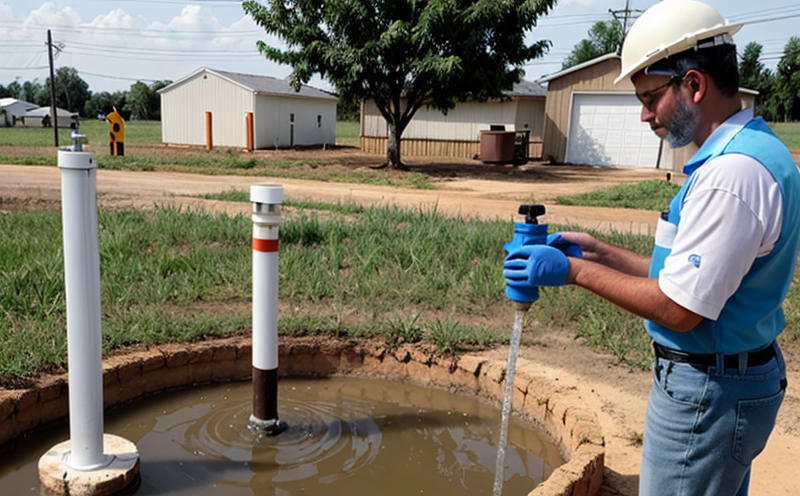ISO 9698 Gross Beta Activity Testing
The ISO 9698 standard is a crucial method used to determine gross beta activity in water and soil samples. This test is particularly important for assessing the presence of radioactive elements that could pose health risks, especially in groundwater quality testing. The process involves extracting beta-emitting radionuclides from the sample matrix using specific chemical reagents followed by counting these emissions with a low-background gamma ray detector.
The significance of gross beta activity measurement lies in its ability to detect and quantify beta emitters like tritium, strontium-90, carbon-14, and other radionuclides. This information is vital for ensuring compliance with drinking water standards set by regulatory bodies such as the U.S. Environmental Protection Agency (EPA) and the World Health Organization (WHO).
The testing method typically includes a series of steps: sample collection, filtration, elution, drying, weighing, dissolution, and finally beta counting using a low-background Geiger counter or scintillation detector. The accuracy of these measurements is paramount for reliable results.
For effective gross beta activity testing, it's essential to follow the guidelines outlined in ISO 9698 meticulously. Compliance with this standard ensures that laboratories provide consistent and accurate data, which is critical for regulatory compliance and public health protection.
The process also involves detailed quality assurance measures such as using certified reference materials (CRMs), performing inter-laboratory comparisons, and adhering to strict calibration protocols. These steps ensure the reliability of the test results and enhance confidence in the testing outcomes.
Groundwater is often a primary source of drinking water, making it crucial to monitor its quality rigorously. The ISO 9698 gross beta activity test plays a significant role in this monitoring process by providing insights into potential contamination from radioactive sources. This information helps stakeholders make informed decisions about the safety and suitability of groundwater for consumption.
Understanding the environmental context is important when discussing this testing method. Groundwater supplies approximately 30% of the world's freshwater resources, and any contamination can have severe consequences on both human health and ecosystems. Therefore, accurate monitoring through methods like ISO 9698 gross beta activity testing becomes indispensable.
The standard also emphasizes the importance of considering background radiation levels when interpreting results. This consideration ensures that any detected beta activity is correctly attributed to potential contamination rather than natural background radiation.
Why Choose This Test
Selecting ISO 9698 gross beta activity testing for groundwater quality assessment offers several advantages:
- Precision and Reliability: The standard ensures consistent and accurate results, which are critical for regulatory compliance.
- Comprehensive Coverage: It covers a wide range of beta-emitting radionuclides relevant to groundwater quality.
- Regulatory Compliance: ISO 9698 aligns with international standards and is widely accepted, ensuring that results are valid across different jurisdictions.
- Health and Safety: By detecting potential contamination early, this testing helps protect public health from radioactive hazards.
The precision and reliability of the test result in trustworthy data that can be used to make informed decisions. Regulatory compliance ensures that water supplies meet stringent safety standards, while the detection of beta-emitting radionuclides provides critical information for protecting human health.
Choosing this test also means leveraging a method that is widely recognized and accepted internationally. This recognition enhances credibility and trust in the results, making it easier to communicate findings across borders or within multinational organizations.
International Acceptance and Recognition
The ISO 9698 gross beta activity testing standard enjoys widespread acceptance and recognition globally due to its robustness and reliability. It has been adopted by numerous countries, including the United States, Canada, Europe, Australia, and many others, as a benchmark for assessing groundwater quality.
International standards like ISO 9698 provide a common framework that ensures consistency in testing methods across different regions. This uniformity is crucial for facilitating international cooperation in environmental monitoring and management.
The standard's recognition extends beyond mere compliance; it also fosters trust among stakeholders, including regulators, policymakers, and the public. By adhering to ISO 9698, laboratories demonstrate their commitment to providing accurate, reliable, and consistent results, thereby enhancing overall confidence in groundwater quality assessment processes.
Moreover, international acceptance of this standard facilitates collaboration between countries and organizations working on environmental issues. This cooperation is vital for addressing global challenges such as climate change, water scarcity, and pollution control.
Environmental and Sustainability Contributions
- Reduction in Contamination Risks: By identifying radioactive contamination early, ISO 9698 helps prevent further spread of contaminants into larger water systems.
- Protection of Ecosystems: Ensuring the quality of groundwater through this testing method helps protect aquatic life and ecosystems dependent on these sources.
- Sustainable Water Management: Accurate monitoring supports sustainable practices by guiding appropriate interventions to maintain water quality standards.
- Health Protection: Early detection of radioactive contaminants ensures that public health is prioritized, reducing the risk of adverse effects from long-term exposure.
The ISO 9698 gross beta activity testing method contributes significantly to environmental sustainability by promoting responsible management and use of water resources. It plays a vital role in ensuring that groundwater supplies remain safe for drinking and other uses, thereby supporting sustainable development goals.
By reducing contamination risks, protecting ecosystems, and supporting sustainable practices, this test helps create a more resilient environment capable of withstanding the pressures of increasing populations and industrial activities.





